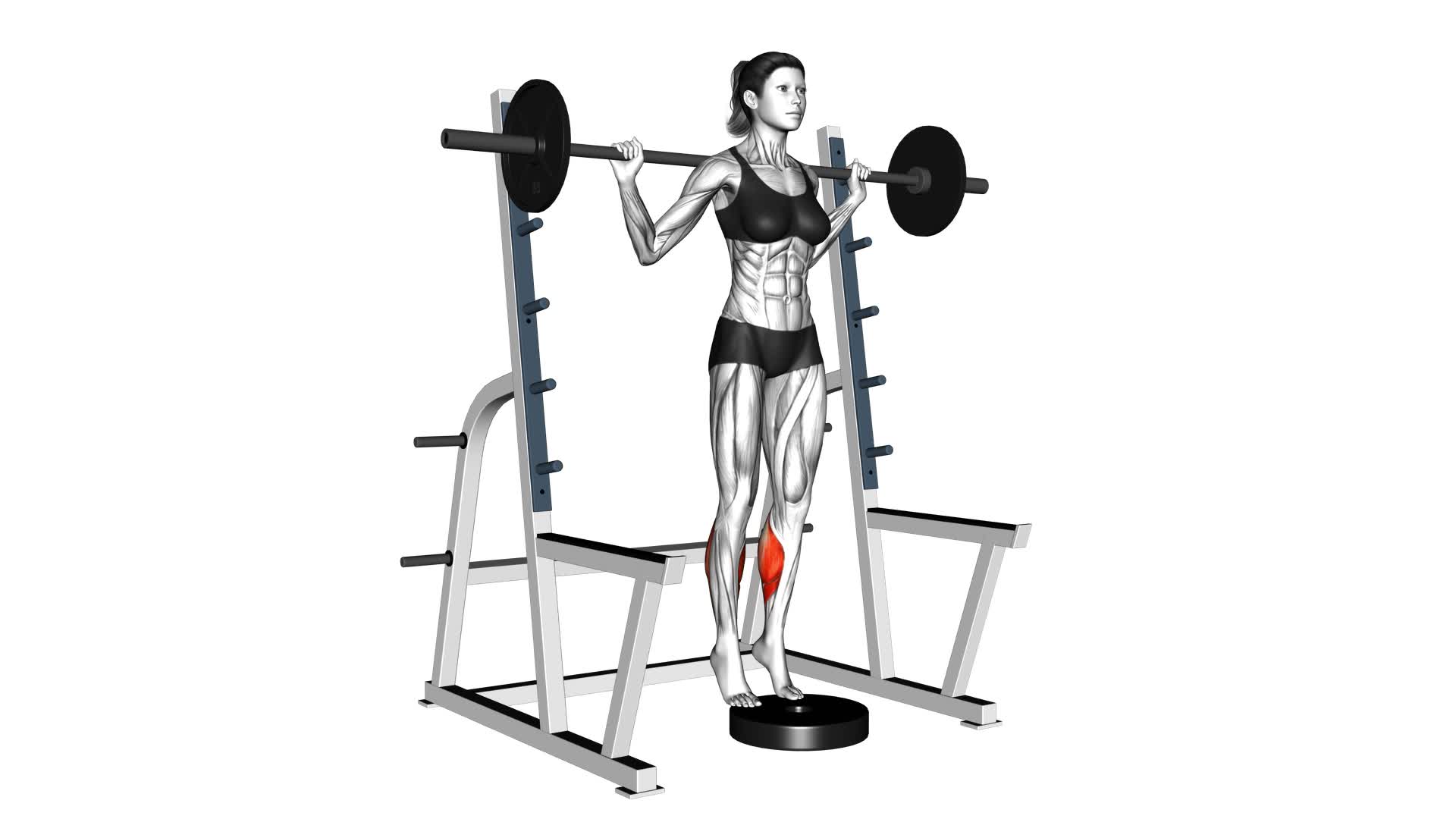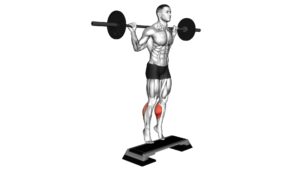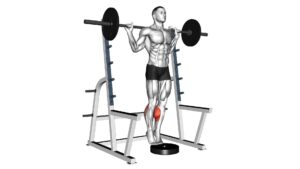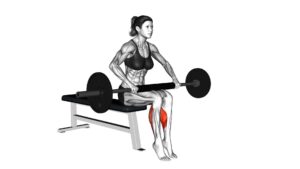Barbell Standing Calf Raise (female) – Video Exercise Guide & Tips

Are you looking to strengthen and tone your calf muscles?
Watch This Exercise Video
Then the barbell standing calf raise is the perfect exercise for you!
In this video exercise guide, we'll show you the proper equipment and setup, as well as a step-by-step guide on how to perform this exercise correctly.
We'll also cover common mistakes to avoid and provide tips for maximizing your results.
Get ready to rock those calf muscles!
Key Takeaways
- Improved calf strength and muscle definition
- Targets the gastrocnemius and soleus muscles
- Can be varied for different areas of the calf muscles
- Proper equipment and setup are important for optimal results
Benefits of Barbell Standing Calf Raise
The benefits of the Barbell Standing Calf Raise include improved calf strength and muscle definition. This exercise specifically targets the calf muscles, helping to strengthen and tone them. By incorporating variations of calf raises into your workout routine, you can further enhance the benefits and challenge your calf muscles in different ways.
One of the main benefits of the Barbell Standing Calf Raise is calf muscle strengthening. This exercise specifically targets the gastrocnemius and soleus muscles, which make up the calf muscles. As you raise your heels off the ground, you're contracting these muscles, forcing them to work against the resistance of the barbell. Over time, this increased resistance will lead to stronger calf muscles.
In addition to calf muscle strengthening, the Barbell Standing Calf Raise also helps improve muscle definition. As you perform the exercise, the calf muscles contract and lengthen, creating tension and promoting muscle growth. This results in a more toned and defined appearance in the calves.
To further enhance the benefits of the Barbell Standing Calf Raise, you can incorporate variations of calf raises into your routine. This can include performing the exercise with different foot positions, such as toes pointed inwards or outwards, to target different areas of the calf muscles. Additionally, you can vary the amount of weight used or the number of repetitions performed to challenge your muscles in different ways.
Proper Equipment and Setup
Now let's talk about how to properly set up the equipment for the Barbell Standing Calf Raise.
When it comes to equipment options for this exercise, you have a few choices. Here are some variations of calf raises that you can try:
- Using a Smith machine: This equipment provides stability and allows you to adjust the height of the bar. It's a great option for beginners or those who prefer a controlled movement.
- Using a barbell and weights: This traditional setup requires you to load weights onto a barbell. It offers a greater range of motion and allows you to challenge yourself with heavier weights as you progress.
- Using a calf raise machine: This machine specifically targets the calf muscles and provides a guided movement. It's a convenient option for isolating the calves and focusing on their development.
By choosing the right equipment for your needs and preferences, you can optimize your calf raise workout and achieve the desired results.
Now that you know about the equipment options, let's move on to the step-by-step guide to perform the exercise.
Transition: With the equipment properly set up, it's time to delve into the step-by-step guide for the Barbell Standing Calf Raise.
Step-by-Step Guide to Perform the Exercise
To begin the Barbell Standing Calf Raise exercise, position yourself with the barbell resting on your shoulders. Stand with your feet shoulder-width apart and toes pointing forward. Ensure that your core is engaged and your back is straight throughout the exercise.
Next, lift your heels off the ground by extending your ankles. Rise up onto the balls of your feet as high as possible. Hold this position for a brief moment, feeling the stretch in your calf muscles.
Slowly lower your heels back down to the starting position, allowing your calves to stretch fully. Repeat this movement for the desired number of repetitions.
To increase the intensity of the exercise, you can perform the Barbell Standing Calf Raise on an elevated surface, such as a step or a weight plate. This variation allows for a greater range of motion and further calf muscle strengthening.
In the next section, we'll discuss common mistakes to avoid during the Barbell Standing Calf Raise exercise to ensure proper form and maximize its benefits.
Common Mistakes to Avoid
Avoidance of proper form and technique is a common mistake in the Barbell Standing Calf Raise exercise. To ensure you perform this exercise safely and effectively, it's important to avoid the following mistakes:
- Using too much weight: Adding excessive weight can lead to injury, especially if your form is compromised. Start with a lighter weight and gradually increase as you become more comfortable and confident.
- Neglecting the full range of motion: It's vital to perform the exercise through a complete range of motion to engage the calf muscles fully. Avoid shallow movements that limit the effectiveness of the exercise.
- Failing to modify for individual needs: Everyone's body is different, so it's essential to modify the exercise to suit your specific needs. Consider using a step or a block to elevate your heels if you have limited ankle flexibility.
By avoiding these mistakes, you can reduce the risk of injury and maximize the benefits of the Barbell Standing Calf Raise.
Now, let's move on to the next section, where we'll provide you with tips for maximizing your results.
Tips for Maximizing Results
To maximize your results in the Barbell Standing Calf Raise exercise, focus on the following tips.
- Pay attention to your nutrition. A well-balanced diet is essential for muscle growth and recovery. Make sure to consume enough protein to support muscle development and repair. Additionally, include healthy fats and carbohydrates to provide energy for your workouts. Hydration is also key, so drink plenty of water throughout the day.
- Incorporate stretching techniques into your routine. Prior to starting the exercise, perform dynamic stretches to warm up your calf muscles. This will help increase blood flow and flexibility, reducing the risk of injury. After your workout, engage in static stretches to improve flexibility and prevent muscle tightness.
- Gradually increase the intensity and weight of the exercise over time. Start with a weight that challenges you but allows you to maintain proper form. As you get stronger, gradually increase the weight to keep pushing your muscles to adapt and grow.
- Be consistent. Aim to perform the Barbell Standing Calf Raise exercise at least two to three times per week to see significant results. Remember to listen to your body and rest when needed to prevent overtraining and allow for proper recovery.
Frequently Asked Questions
What Are Some Alternative Exercises That Target the Same Muscles as the Barbell Standing Calf Raise?
Looking for alternative calf muscle exercises?
If you're looking to switch up your routine, there are a few standing calf raise alternatives you can try.
One option is the dumbbell standing calf raise, which uses dumbbells instead of a barbell.
Another option is the seated calf raise, where you sit down and lift your heels using a machine or weights.
Remember to choose a weight that challenges you but allows for proper form.
How Often Should I Incorporate Barbell Standing Calf Raises Into My Workout Routine?
To get the benefits of barbell standing calf raises, incorporate them into your workout routine regularly.
By doing this exercise, you can strengthen and tone your calf muscles effectively.
To perform it properly, position the barbell on your shoulders, raise your heels, and then lower them slowly.
Make sure to use a weight that challenges you, but allows you to maintain proper form.
Including barbell standing calf raises in your routine will help you achieve maximum results.
Can I Perform Barbell Standing Calf Raises if I Have a Pre-Existing Calf Injury?
If you have a pre-existing calf injury, it's important to take precautions when performing barbell standing calf raises. Instead of doing this exercise, consider alternative exercises for calf injuries such as seated calf raises or calf raises using a resistance band.
Additionally, you can modify the barbell standing calf raise by using lighter weights or performing the exercise on a raised platform to reduce strain on your calves. Remember to consult with a healthcare professional before starting any new exercises.
What Are Some Variations of the Barbell Standing Calf Raise That I Can Try for Added Challenge?
Looking to add some variety and challenge to your barbell standing calf raises?
There are a few variations you can try.
One option is to perform the exercise on a step or elevated surface, which increases the range of motion and targets the calves differently.
Another variation is to use a single-leg stance, which adds instability and engages your core for added benefits.
Lastly, you can incorporate pauses at the top and bottom of the movement to increase time under tension and further stimulate muscle growth.
How Long Should I Hold the Raised Position During the Exercise?
During the barbell standing calf raise, it's important to hold the raised position for a few seconds to fully engage your calf muscles. This helps to increase the intensity and effectiveness of the exercise.
By holding the position, you're challenging your calves to work harder and build strength. Aim to hold the raised position for about 2-3 seconds before slowly lowering your heels back down.
Remember to focus on maintaining proper form throughout the exercise.
Conclusion
In conclusion, the barbell standing calf raise is a highly effective exercise for strengthening and toning the calf muscles.
By following the proper equipment setup and step-by-step guide, you can perform this exercise correctly and avoid common mistakes.
Remember to focus on maintaining good form and engaging the calves throughout the movement for maximum results.
Incorporating this exercise into your routine will help you achieve stronger and more defined calf muscles.

Author
Years ago, the spark of my life’s passion ignited in my mind the moment I stepped into the local gym for the first time. The inaugural bead of perspiration, the initial endeavor, the very first surge of endorphins, and a sense of pride that washed over me post-workout marked the beginning of my deep-seated interest in strength sports, fitness, and sports nutrition. This very curiosity blossomed rapidly into a profound fascination, propelling me to earn a Master’s degree in Physical Education from the Academy of Physical Education in Krakow, followed by a Sports Manager diploma from the Jagiellonian University. My journey of growth led me to gain more specialized qualifications, such as being a certified personal trainer with a focus on sports dietetics, a lifeguard, and an instructor for wellness and corrective gymnastics. Theoretical knowledge paired seamlessly with practical experience, reinforcing my belief that the transformation of individuals under my guidance was also a reflection of my personal growth. This belief holds true even today. Each day, I strive to push the boundaries and explore new realms. These realms gently elevate me to greater heights. The unique combination of passion for my field and the continuous quest for growth fuels my drive to break new ground.







